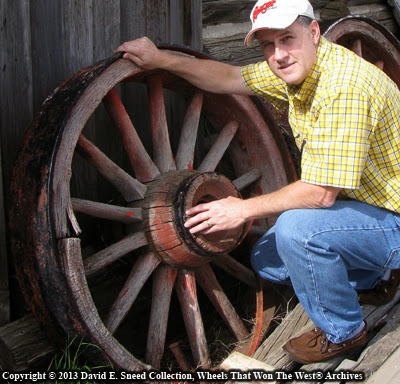As we shared in Part 1 of last week's blog, America's early transportation industry included thousands of heavy vehicle makers spread throughout the U.S. Several years ago, we produced a Limited Edition print showcasing many who are often recognized as being among the most prominent brands seen on the western frontier. Clearly, with such a large number of builders, the process of identifying wagons that have lost their obvious markings can be tough. While a healthy dose of experience as well as period literature for comparisons can be helpful, that combination isn't always available. So, what do you do if you're trying to get information on a wagon maker and don't have access to sufficient catalog illustrations and photography?
First... it's important to remember that all parts of the vehicle can hold clues. Detail after detail, every element should receive close attention, including written and photographic documentation. Second... particular care should be given to the vehicle's surface, avoiding any cleaning or treatment that could permanently alter original features. Third... it's equally vital to avoid the trap of assuming that similar designs on different wagons always translate into features from the same maker. Over and over, we run across circumstances where someone has inaccurately labeled a vehicle because it appeared to look the same as another of known heritage. It's worth repeating here that "SIMILAR DOES NOT NECESSARILY MEAN 'THE SAME'."
Documentation
In absence of a thorough knowledge of the most commonly known early builders, the best place to start the identification process is to methodically comb the entire vehicle. You should document any and all details related to part designs, construction designs, markings, colors, part placements, part sizes, and so forth. It will also be important to note non-original elements of a wagon. As such, the review may require the assistance of someone familiar with the authentication process. The overall evaluation can be a tedious task but accuracy demands focus and attention to detail. Diving into the assessment, we typically divide these vehicles into three major areas - Wood, Paint, and Metal. To that point, back in 2009, I wrote a first-of-its-kind feature article in the April issue of Farm Collector magazine. That piece served as a fundamental guide to identifying wagons and other western vehicles. Below are some highlights from that introduction.
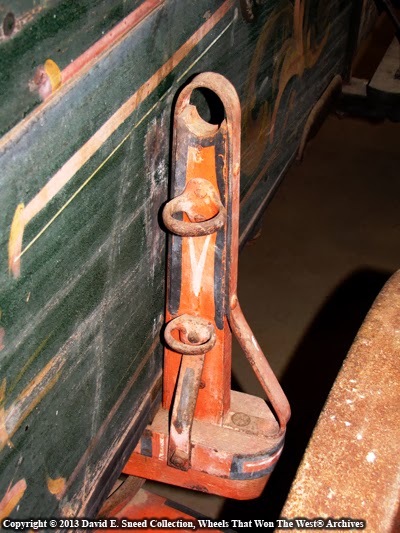
Both the metal and paint design of this bolster standard provide strong evidence of a Stoughton brand wagon.
Paint
When it comes to evaluating paint, it's important to look at all areas - including the tops of bolsters as they can sometimes hold additional information. Stenciling, logos, striping, colors, and even placement of colors are all important historical traits to document. Faded paint and hard-to-read lettering may create a seemingly impassable obstacle. Careful application of small amounts of distilled water, however, may be helpful in certain instances. By temporarily wetting the wood, both signage and other paint markings can become more legible and clear. With that said, we'll also note that areas should be tested first to ensure that moisture will not harm the surviving surface paint. Lighter pigmented or thin paint may be especially vulnerable to even small amounts of water. Photographing all of your findings is equally helpful as you compare and review potential identities. Finally, if the original paint is hidden beneath an old repaint job or perhaps a heavy coating of linseed oil, you may wish to employ assistance with the careful removal of this material. We know of a number of rare vehicles whose values were saved - and increased - by the recovery of good paint beneath a non-original surface coating.
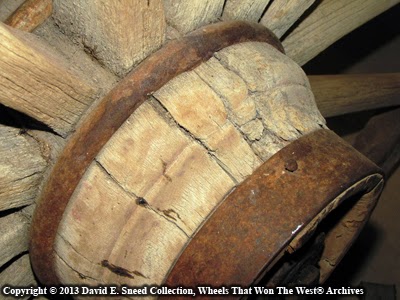
Wood features such as the single groove in this hub combined with notable metal distinctions such as rounded spoke bands and other details point to Studebaker as the maker.
Wood
The wood within every wagon can also contain vital information. Here again, details make the difference. Take your time and scour the vehicle top to bottom. I've found numerals, symbols, dates, and alpha characters stamped or pressed into the wood. These elements are not always easy to see. In fact, most cursory reviews of a wagon can easily miss these brand indicators. From the insides of the boxes to the floorboards and countless gear and wheel locations, it's possible for details to be on almost any wooden surface. While these construction records may not immediately point to a maker, the collective power of all the clues can be helpful in narrowing down the list of possible manufacturers.
The shape, type, and contouring of the wood can also hold valuable evidence. Pay particular attention to the design of the sideboard cleats, cross sills, wheel hubs, hound designs, bolster stakes, and even the reach. While the end gates can also be helpful, these pieces are often transitory - in other words, they may have been replaced at some point with a non-original substitute. It's one more potential pitfall that requires careful scrutiny before assigning an identity.
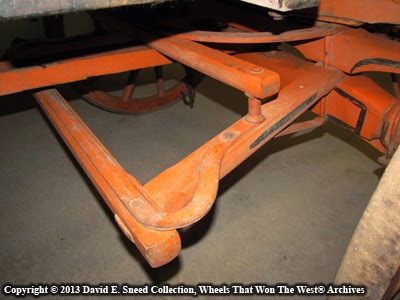
Both the paint and metal design of this front hound are typical of many twentieth-century-built Springfield wagons.
Metal
Wrap-Up
As a note of encouragement to those stumped by a wagon's identity, we offer a complimentary initial review of these vehicles. If your set of wheels can be easily identified through quick visual clues, we're happy to assist at no cost. Should the vehicle require more research, we're equally pleased to discuss the value of a more detailed review. Ultimately, when it comes to determining the significance and worth of any of these pieces, the presence of a known maker can have an important impact. After all, it's where the vehicle's story begins and that heritage can make all the difference when it comes to resale value and collector interest.
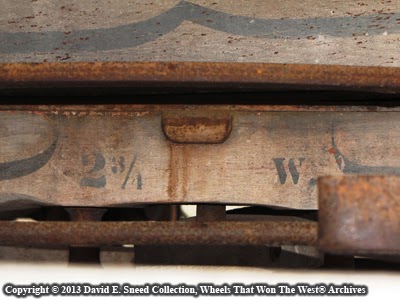
The faded numbers and lettering shown here are references to this wagon's skein size and track width.
Just as a reminder... If you haven't signed up to receive notifications every time we update this blog and other areas of our website - www.wheelsthatwonthewest.com - just type in your address in SIGN UP link in the upper right of our website pages. Please don't hesitate to let us know if we can be of assistance and we'll look forward to sharing even more details on early wagons and western vehicles each week.
